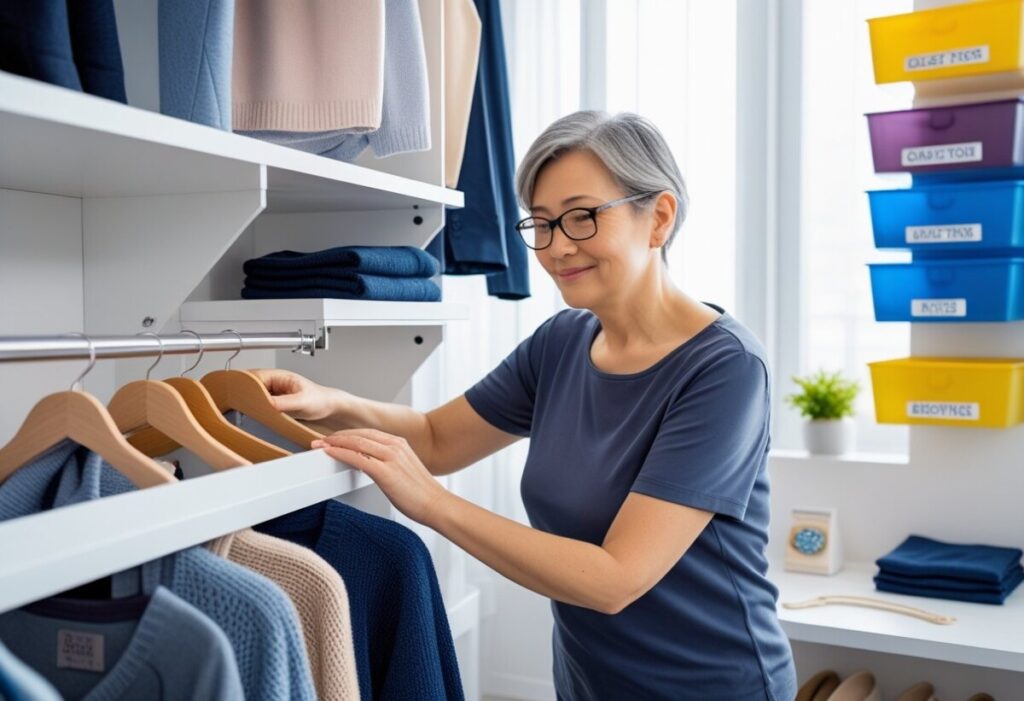Smart Homes
Clothing Organization and Dressing Aids for People with Low Vision
Essential Clothing Organization Strategies for Low Vision Efficient clothing organization can make daily dressing tasks more manageable for individuals with visual impairment. Practical strategies such as organizing clothes by color and texture, optimizing closet layouts, and using adaptive storage solutions can greatly increase independence and ease of use. Organizing Wardrobe by Color and Texture Sorting…
Read MoreMeal Preparation Tips for People with Low Vision: Strategies for Safe and Efficient Cooking
Essential Kitchen Tools for Meal Prep with Low Vision Adapting meal prep for low vision requires careful organization and specific tools. Focusing on tactile guidance, voice assistance, and stability helps make the kitchen safer and meal prep more manageable. Adaptive Cutting Boards Adaptive cutting boards provide increased safety and efficiency for people with low vision…
Read MoreChoosing the Right Phone and Communication Tools for Low Vision Users: Essential Features and Expert Tips
Key Factors When Choosing Phones for Low Vision Users Selecting a phone for someone with visual impairment is not just about features—it’s about matching the device to individual needs, practicality, and budget. The best results come from understanding vision challenges, comparing usability, and choosing options that balance affordability with simplicity. Assessing Visual Needs and Usability…
Read MoreBathroom Safety Tips for Adults with Low Vision: Essential Strategies for Preventing Accidents
Essential Bathroom Modifications for Adults With Low Vision Bathroom safety is critical for individuals with low vision, and making targeted modifications can prevent common accidents. The right lighting, contrast, supportive hardware, and functional fixtures help create a safer, more accessible bathroom. Improving Lighting and Contrast Proper lighting reduces shadows and helps highlight important features in…
Read MoreLabeling Tips for Low Vision: Essential Strategies for Clear and Safe Item Identification
Fundamentals of Labeling for Low Vision Clear and accessible labeling tips for people with low vision. Identification empowers us to maintain independence, boost self-sufficiency, and ensure our safety at home. A thoughtful, organized approach to identifying household items improves daily life and supports effective vision rehabilitation and independent living. Understanding Low Vision and Visual Impairment…
Read MoreTop Household Tools for Low Vision Users to Simplify Daily Living and Boost Independence
Essential Vision Assistance Tools for Daily Living Choosing the right vision assistance tools makes it easier to manage daily household activities, read instructions, and stay organized. The right solutions improve safety and independence for people with low vision or visual impairment. Low Vision Devices for Home Tasks Low vision devices make daily living more practical…
Read MoreSmart Home Organization Tips for People Living with Low Vision: Maximizing Accessibility and Efficiency
Essential Principles of Smart Home Organization for Low Vision Smart home organization can transform how we live with visual impairment. Thoughtful changes allow us to improve daily routines, reduce risks, and support personal independence. Focusing on efficiency, comfort, and clear navigation is the best foundation for a safe and accessible home environment. Understanding Low Vision…
Read MoreHome Lighting for Vision Impairment: Best Options to Improve Visibility and Comfort
Understanding Vision Impairment and Lighting Needs Explore home lighting for vision impairment by examining the unique visual challenges and how appropriate lighting directly supports everyday living. The right lighting can help improve clarity, comfort, and confidence for individuals with low vision or other visual impairments. Types of Visual Impairments Visual impairment takes many forms, from…
Read MoreSimple Kitchen Modifications and Safety Tips for Low Vision Adults
Essential Kitchen Modifications for Low Vision Making the kitchen safer and more accessible for adults with low vision involves both visual and organizational adjustments. Small changes with lighting, color contrast, and layout can greatly improve daily living skills and help people with visual impairment maintain their independence. Improving Color Contrast for Safety Enhancing color contrast…
Read MoreStrategies for Independent Living for Deaf-Blind Individuals: Essential Tips and Techniques
Embracing Independence with Effective Strategies Living independently as a deaf-blind individual comes with unique challenges, yet it’s entirely possible with the right strategies and support. Utilizing assistive technology specifically designed for visual and hearing impairments can transform daily experiences, enhancing confidence and self-reliance. Our commitment at New England Low Vision and Blindness is to guide…
Read MoreSenior Help with iPhones, Alexa, and Remotes: Simplified Tech Support Guide
Navigating modern technology can be challenging, especially for seniors who may not have grown up with it. At New England Low Vision and Blindness, we understand the importance of staying connected and engaged with the world. This guide aims to simplify the use of iPhones, Alexa, and remote controls, offering straightforward, supportive steps. Our trainers…
Read MoreIn-home Device Setup Assistance for Elderly: Streamlining Home Technology
In today’s fast-paced world, smart home technology offers incredible potential for making life easier, especially for older adults who wish to age in place comfortably. We simplify the process of setting up in-home devices to ensure they are accessible and beneficial. Whether it’s a smart speaker for hands-free control or a security camera for added…
Read More











